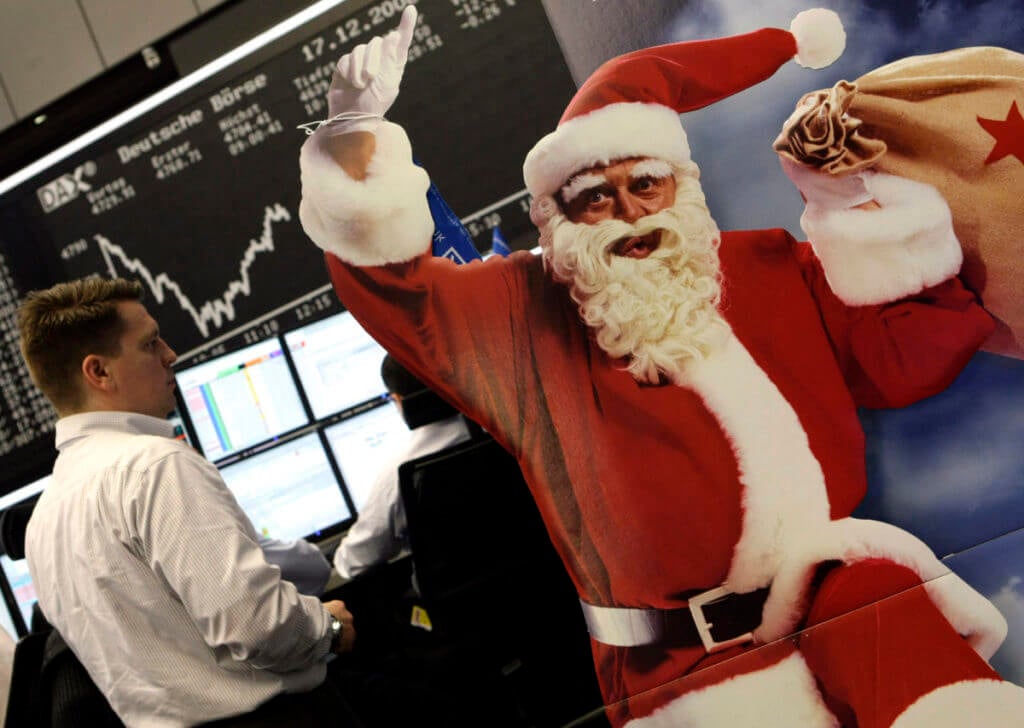Stock Market Gurus Promised You a Santa Claus Rally – What Happened?

Santa Claus left coal under the stock market's tree this year. What does that mean for 2020? | Source: REUTERS / Alex Grimm
- Analysts jawed on and on about the Santa Claus rally, but the market hasn’t made any ground since Christmas.
- Why did St. Nick leave investors coal under the tree?
- Maybe Wall Street had too much egg nog this year. Now that it’s wearing off, we’re going into 2020 with better vision when it comes to valuations.
Just as holiday retail advertising has crept earlier and earlier into November, so has talk of the stock market’s annual “Santa Claus rally” on Wall Street.
Analysts were already looking forward to 2019’s Santa Claus rally well before Thanksgiving. Stock market bulls were salivating by mid-November, everywhere from Yahoo Finance , to Reuters , to CNBC :
That Reuters link above quotes Tim Ghriskey, chief investment strategist at Inverness Counsel in New York:
Between now and the end of the year, I’m assuming there will be a Santa Claus rally.
Ghriskey and other stock bulls made a pretty safe call. Santa shows up most years for the last five trading days in December :
Since 1950, the S&P 500 SPX, -0.15% has gained an average of 1.3% during this stretch, about six-and-a-half times the average seven-day rolling performance of 0.2%, according to Dow Jones Market Data.
But not so this year.
Stock Market Lands on St. Nick’s Naughty List This Year

Instead of making some welcome above-average gains since Christmas, the S&P 500 has actually slipped a little over the last five days.
Rather than cheering up investors with a jolly, “Ho ho ho!” Kris Kringle’s taunting Wall Street with a mischievous “Ho ho no!”
So why aren’t stocks on the nice list?
One precious metals wholesaler has a snarky, but potentially valid theory:
Maybe Wall Street’s hungover from too much egg nog on Christmas. Investors bought stocks higher on strong retail sales numbers.
But now markets have buyer’s remorse as they get a better look at the fundamentals underlying those sales. Much of that holiday spending on gifts and stocks was financed with a glut of debt, not an excess of productivity.
Then there’s the massive expansion of the Federal Reserve’s balance sheet in daily repo operations since September. The flood of liquidity has led analysts to predict a looming stock market crash.
The Fed repo operations are a bit too reminiscent of the bank run scene from the Christmas classic film, “It’s a Wonderful Life,” when the town’s people try to withdraw their money from the bank and learn their money isn’t there.
Wall Street’s Vision Clears up in Time for 2020
With the Phase One US-China trade agreement buttoned up (and already priced in by the market throughout December), Wall Street’s biggest worry going into 2020 is what the Fed repo operations mean for the economy .
Since a fresh flood of liquidity started in September, there have been murmurs that it’s another round of quantitative easing , the unprecedented monetary expansion the Fed undertook to fight the Great Recession.
That would mean the Fed sees danger ahead for the economy, and possibly recession. Looks like Santa Claus does too. The Stock Trader’s Almanac defines the Santa Claus rally as the last five trading days of the year. It warns :
Santa’s failure to show tends to precede bear markets, or times stocks could be purchased later in the year at much lower prices.
But a correction in 2020 isn’t necessarily something to fear. That’s when we find out which companies have really been virtuous, and which ones have been coasting along, borrowing against future promises they won’t be able to keep.
Or as Warren Buffett likes to say:
You never know who’s swimming naked until the tide goes out.
With the sober outlook produced by hard times, the market can more efficiently allocate capital to its most productive uses again.